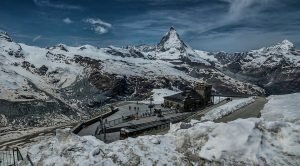Sion (or Sitten in German) is the capital city of Valais. It is situated in the south west of Switzerland at the confluence of the Sionne and Rhone at an elevation of approximately 500 m. The city lies in the Rhone Valley and is surrounded by the Alps. Over 70 % of the population speaks French, but Swiss German can be heard now and again as it is the mother tongue of a good 20 % of the community.
How old is Sion?
The town is one of the oldest places „vo dr gsamte Schwiiz“ (en: of the whole of Switzerland) and has been populated for over 5‘000 years. This has been proven by the many archeological digs in the area. One such dig uncovered stone age dolmens at Petit Chasseur. Of special interest are the over 200 Celtic graves dating back to the early „Iiszit“ (en: ice age). Together they comprise one of the largest necropolises in the Alpine regions. When the Romans drove the Celts out of the area, they founded the town of Sedunum.
The rise of Sion
In 580 AD, the bishops of Martigny moved the seat of the bishopric to Sion and that is when Sion started gaining importance. Today, Sion has a population of 30‘000. The thriving town‘s main revenue is from tourism, but wine and vegetable growing are also important sources of income. Sion, like the rest of the Valais, has a very mild climate and is known to be in the sunniest part of Switzerland. The place is also an important transport hub; it is situated along two international rail lines (Simplon and Lausanne-Brig) and also has an international airport. The large bus terminal is the starting point for both tourists and locals who wish to travel to many of the side valleys of the Valais as well as to the internationally renowned „Schiigebiet“ (en: skiing areas) of Crans-Montana, Anzere and Val d´Herens.
Sights in Sion

Practically every visitor to Sion is charmed by it picturesque location sitting between two cliffs. Perched on top of one of the cliffs, the Tourbillon, are the ruins of a bishop‘s castle from the 13th century. „Ufem zweite Felse“ (en: On the second cliff), Valere, is an old pilgrimage church from the 11th century. The basilica of Valeria is home to one of the oldest still existing organs in the world. The organ dates from the 15th century and is played once a year in summer during a special festival of old organs.
The historical old town
The historical old town of Sion with its quaint medievel buildings is beautiful. Within the old town there is a lovely place of worship, the Cathedral of Notre Dame du Glarier which belongs to the bishopric of Sion. Its oldest parts date back to the 11th to 13th century, but it has been reconstructed many times „im Lauf vo de Joorhundert“ (en: through the centuries). Today, the three-aisled basilica with the massive Roman tower dominates the townscape. The gothic altar triptych showing the lineage of Jesus, the „Wurzel Jesse“ (en: roots of Jesse) is internationally renown. Worth visits are also the nearby late gothic church of St. Teodule and the council church of Sainte Trinite. The beautiful Renaissance town hall featuring an „astronomischi“ (en: astronomical) clock tower and old roman inscription stones in the stair hall can be found east of the basilica.
Eating out in Sion
 Of course, there are many taverns „mit typisch Schwiizerischer Chuchi“ (en: with typical Swiss cuisine) in the lanes and squares of Sion. Typical fare for Sion, indeed for the whole of the Valais, is raclette, cheese fondue as well as hearty sausages and smoked bacon. Another local delicacy is a dish with an unappetising name: the „Cholera aus dem Goms“ (en: cholera from Goms) is a pie with potatoes, apples, leeks, onions and a lot of cheese. This is a tasty dish which used to be considered as „Armi Lüt-Esse“ (en: poor people’s food).
Of course, there are many taverns „mit typisch Schwiizerischer Chuchi“ (en: with typical Swiss cuisine) in the lanes and squares of Sion. Typical fare for Sion, indeed for the whole of the Valais, is raclette, cheese fondue as well as hearty sausages and smoked bacon. Another local delicacy is a dish with an unappetising name: the „Cholera aus dem Goms“ (en: cholera from Goms) is a pie with potatoes, apples, leeks, onions and a lot of cheese. This is a tasty dish which used to be considered as „Armi Lüt-Esse“ (en: poor people’s food).
Surrounding areas
The rustic village of Raron is around 10 km away just outside the gates of Sion. The village was home to the poet Rainer Maria Rilke in his last years and his grave is also here. Also nearby is the village of Visperterminen with the highest „Wiiberg“ (en: vineyard) in Europe. Here, you can taste and buy the much accoladed wine made out of the Heida grape as well as experience Swiss culture and traditions.
Hiking in Sion
Sion is wonderfully located for hiking trips. A chair lift will take you up from the village to the 2000 m high mountain Giw, a paradise for skiing and hiking. Just 15 km out of Sion is the artificial lake, Lac des Dix, with the highest dam wall, Grande Dixense, in Europe; it is the fifth highest dam in the world. A gondola takes visitors comfortably and safely from the foot of the dam to the top where you can enjoy a fantastic view. Lake Thun, just 22 km away from Sion, is well worth a visit. The lake is in the canton of Berne and is one of the most popular holiday regions in Switzerland.
View of the Matterhorn

If you are already in Sion, it is practically a must to visit the Matterhorn. At an „Entfernig“ (en: distance) of merely 35 km away, it is not far at all. This mountain with its world famous shape and impressive height of 4’448 m is a tourist magnet like no other. There is no cable car that can take you up and climbing the mountain should be left to experienced climbers, but you can enjoy the breathtaking view of the Matterhorn from Zermatt, which lies just below. Zermatt also has an interesting Matterhorn museum.
A different kind of Switzerland
Sion is different to German speaking Switzerland; French is the main language spoken here. But don’t let that stop you from visiting. You will still hear a lot of Swiss German being spoken, as we Swiss Germans spend a lot of our leisure time in Sion.
Vocabulary list
Vo dr gsamte Schwiiz – of the whole of Switzerland
Iiszit – ice age
Schiigebiet – skiing areas
Ufem zweite Felse – on the second cliff
Im Lauf vo de Joorhundert – through the centuries
Astronomischi – astronomical
Mit typisch Schwiizerischer Chuchi – with typical Swiss cuisine
Armi Lüt-Esse – poor people’s food
Wiiberg – vineyard
Entfernig – distance
